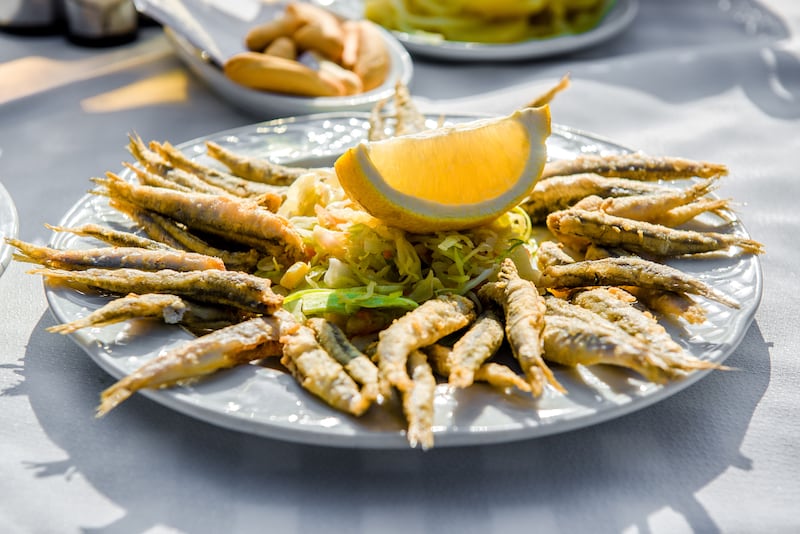Málaga used to be Andalusia’s ugly-duckling city, a scruffy Mediterranean port you either rushed through on your way to the beaches of the Costa del Sol or bypassed altogether for inland metropolises like Granada and Sevilla. No longer: While neighboring Spanish cities have been resting on their laurels—gussying up old monuments, capitalizing on famous one-time inhabitants, and crowing about their storied history—Málaga has kept its eye squarely on the future, adding new flights and high-speed train routes, opening nueva cocina restaurants and bagging Michelin stars, and building more world-class museums in a decade than most cities do in a generation. In other words, all signs pointed to Málaga being a great candidate for our sixth installment of It’s Still a Big World, a series on underrated destinations.
As an adoptive Madrileño with a predilection for underdog destinations from Warsaw to Toulouse to Tbilisi, Málaga had long been on my shortlist. “Málaga is blowing up” my friends in Madrid chided. “You’re a travel writer. How have you not gone yet?”
I’d been putting the trip off. The more breathless coverage I read about the city’s improbable renaissance (The New York Times featured it twice in three months), the more I worried that it was losing its rakish edge and becoming another soulless theme park for cruise takers, Instagrammers, and rich retirees. No, gracias. Could a city truly redefine itself virtually overnight while still retaining its essence? With a train ticket in hand and a long weekend ahead of me, I was determined to find out.
Getting there from Madrid was shockingly easy. The AVE, Spain’s high-speed train, plops you at Málaga’s María Zambrano station in two hours and change, three hours less than if you were to drive; from Barcelona, it gets you there in under six hours—compared to 10 behind the wheel. (Note to international travelers: Delta runs daily direct flights to Málaga from JFK in the summer months.)
After dropping my duffel at Molina Lario, a bright urban hotel sandwiched between the sea and the old town, I met up with María Palomares. A certified guide with the Málaga City Tourism Board, Palomares is a petite, straight-shooting señora with a Rain Man-like knack for recalling dates and esoterica—the binary nomenclature of various local snails, for starters. “These are Murex brandaris, what Malagueños call cañaíllas,” she said at our first stop, the century-old Atarazanas Market, pointing to a pile of thumb-size gastropods resting on ice. “Historians think their purple secretions, used for dye across the ancient world, might be what lured the Phoenicians from Tyre to settle here.”
The Phoenicians founded Málaga in the eighth century B.C., which makes it one of the oldest continuously inhabited cities in the world. Compared to the Romans and the Moors, who left plenty of buildings, literature, and art in their wake, relatively little is known about these seafaring ancients, who produced fewer lasting artifacts.

The dome of the cathedral in Malaga rises above the picturesque coastal city in Spain as the sun begins to set.
Moelyn Photos/GettyThat scarcity makes Málaga’s Ifergan Collection, opened in April, precious. On a guided tour I’d take the following day (by appointment only; call ahead) I learned that it houses the world’s most extensive collection of Phoenician relics that run the gamut from jewelry to tools to clay pots. The highlight? A backlit cubbyhole in which you’re surrounded by dozens of religious figurines salvaged from a ship that sank 2,600 years ago—perhaps on its way to Málaga.
Back at the market, Palomares was jump-starting my salivary glands with descriptions of local delicacies like ensalada malagueña (Málagan salad), a rubbly mishmash of salt cod, boiled potatoes, olives, and suprêmed orange segments tossed with lemon juice and olive oil, and ajoblanco, a chilled almond and bread soup garnished with halved green grapes.
We were interrupted by the gravelly voice of a vendor. “Try my famous cracked olives!” he said, holding out a toothpick. I’d been waiting for this moment: Málaga’s aceituna aloreña is so prized that it’s the only type of olive in Spain with an EU-certified designation of origin (D.O.). One bite, and I understood why—it was so meaty and rich that a bowl of them would make a satisfying lunch.

Nerja, Spain.
Alex Tihonov/GettyBut the most captivating stalls were the pescaderías and marisquerías with their bounty of shimmering seafood: blood-red prawns, fat swordfish steaks, heaped baskets of unrecognizable shells, and sardines so lustrous under the lights they almost had me reaching for my sunglasses. Surely many of the latter would end up al espeto, barbecued Málaga-style over hot coals and eaten out of hand.
As Palomares chitchatted with vendors and waved to shoppers she recognized, I felt a sense of relief. Unlike La Boqueria in Barcelona or Mercado de San Miguel in Madrid, Atarazanas Market hadn’t turned into an Eataly-like emporium jammed with selfie-snapping tourists. Málaga may be one of Spain’s trendiest cities, but its central market? Unapologetically, unequivocally old school.
After leaving the market, we snaked our way through one-car-wide streets toward the Alcazaba, an 11th-century palatial citadel built by the Hammudid dynasty that’s Málaga’s most coveted historical site. I knew that the city boasted a Roman amphitheater as well and audibly gasped when I saw its location at the foot of the Alcazaba—take a picture here, and in one frame you can capture the handiwork of two great empires and millennia of Spanish history.

City at the waterfront, Calahonda, Costa Del Sol, Alboran Sea, Andalusia, Spain.
GettyBuilt on a precipice above the Alboran Sea, the Alcazaba is one of the best-preserved Moorish fortresses in Spain, its many horseshoe arches and elaborate arabesques thankfully intact. (Palomares swears that if the Alhambra weren’t an hour and a half away, the Alcazaba would be far more famous.) Entering the complex, we zigzagged up through a series of strategically placed doors designed to slow down invading armies. The higher we climbed, the more the air smelled like jasmine blossoms. The aroma was intoxicating by the time we reached the Plaza de las Armas, where we were greeted by a lush botanical garden, burbling fountains, and sweeping sea views. Close your eyes here, and you can almost hear the muezzin’s calls to prayer.
Málaga’s other brick-and-mortar behemoth is the Catedral de la Encarnación, which locals call La manquita (“The Little One-Armed Lady”) because its southern bell tower was never finished. Neither, according to Palomares, was the roof, which explains why the cathedral is constantly under construction for leaks and structural problems. Despite its flaws, it’s still a Renaissance jewel. Peek inside to see the flamboyantly appointed chapels, and come back at sunset for a 30-minute guided tour of the cubiertas, or rooftops, to snap pics of the terracotta skyline set against the cobalt-blue Mediterranean.

Sunset lighting on Catedral de la Encarnación de Málaga in Old Quarter, Malaga, Spain.
Gary A. Conner/GettyAfter saying adiós to Palomares with Spain’s requisite two kisses, I claimed a barstool at Antigua Casa de Guardia, a 179-year-old bodega where mustachioed waiters pour sherry straight from the barrel and chalk your tab on the elbow-worn bar. Between sips of raisiny vino dulce, I set about figuring out which of Málaga’s 37 museums to visit. There were two non-negotiables: the Centre Pompidou, a much-ballyhooed offshoot of the French modern art museum, opened in 2015, and the Museo Picasso (Picasso was born in Málaga), which gained 166 new works in a 2017 revamp. I reckoned I could tack on one more before museum fatigue set in and (though the new Russian Museum, a St. Petersburg satellite, was tempting) settled on the Carmen Thyssen Museum, which houses the private art collection of the dowager baroness (of Museo Thyssen-Bornemisza fame).
The Centre Pompidou is unmistakable. Housed in an ultramodern spaceship-like building, it’s crowned with a colorful glass cube that peeks anachronistically above the bustling marina. Its permanent collection features works by Frida Khalo, Max Ernst, Joan Miró, Francis Bacon, and more, but I spent twice as long the following morning perusing the temporary exhibition called “Modern Utopias,” on display until 2020, which explores 20th-century ideas of paradise through the lens of artists, filmmakers, and sculptors ranging from Le Corbusier to Marc Chagall.

‘Centro Pompidou Málaga’ at night, Malaga.
Chris Winsor/GettyMaybe the hordes of shouting field-trippers dampened my enthusiasm, but I left the Museo Picasso far less impressed than I did the Centre Pompidou. Sure, there were a few gems, like Bull’s Head, fashioned out of bicycle parts, but most casual art lovers will have trouble recognizing any of the museum’s works: In keeping with the fact that Picasso left Málaga in 1891 at age 10, most of the pieces (largely donated by his heirs) are from his early years and, to the untrained eye, could easily be mistaken for works by other artists.
Both the Museo Picasso and the Carmen Thyssen Museum occupy stunning 16th-century palacios with arcaded interior courtyards and vaulted ceilings decorated with Mudéjar motifs, buildings worth visiting for their architecture alone. Though the Thyssen draws from centuries of European art, the bulk of its collection is 19th-century Spanish with appearances by Marià Fortuny, Ignacio Zuloaga, and Raimundo Madrazo. The Andalusian scenes—of bullfights, landscapes, street scenes, and flamenco dancers—are particularly standout and lend the museum a sense of place that the other two lack.
Of course, you never get a complete picture of a city on a weekend break. Beyond the museums I missed, there are countless cafés to cozy up in, sidestreets to explore, landmarks to tour, and restaurants to try. Málaga might seem quaint compared to Madrid or Barcelona, but it has a pioneering pulse all its own—a rootsy, artistic energy that sucks you in and makes you want to stay awhile. So, stay—the water’s warm, the wine’s cheap, and there’s enough history and culture to keep you busy for weeks.
Where to Stay
The best hotel in town is the Gran Hotel Miramar, a grande dame with ocean views and an on-site spa that reopened in 2017 after a major refurbishment. If you don’t want to feel underdressed walking through the lobby, opt for Hotel Molina Lario, situated steps from most major sights, or the NH Málaga, which just got a new wing and a chic rooftop pool.

Where to Eat
All the guides are right that El Pimpi is a must: The iconic bodega and restaurant has been serving sherry and fried seafood platters in its distinctly Andalusian dining room for decades (see if you can spot the barrels signed by Pablo Picasso and Lola Flores). Far less touristy places to tapa include Mesón Mariano, whose atún encebollado (braised tuna with onions) is a rebuke to the epicures who think tuna must be rare to be good, or El Trillo, where almost every table orders the ventresca-topped tomato salad, a late-summer treat.



